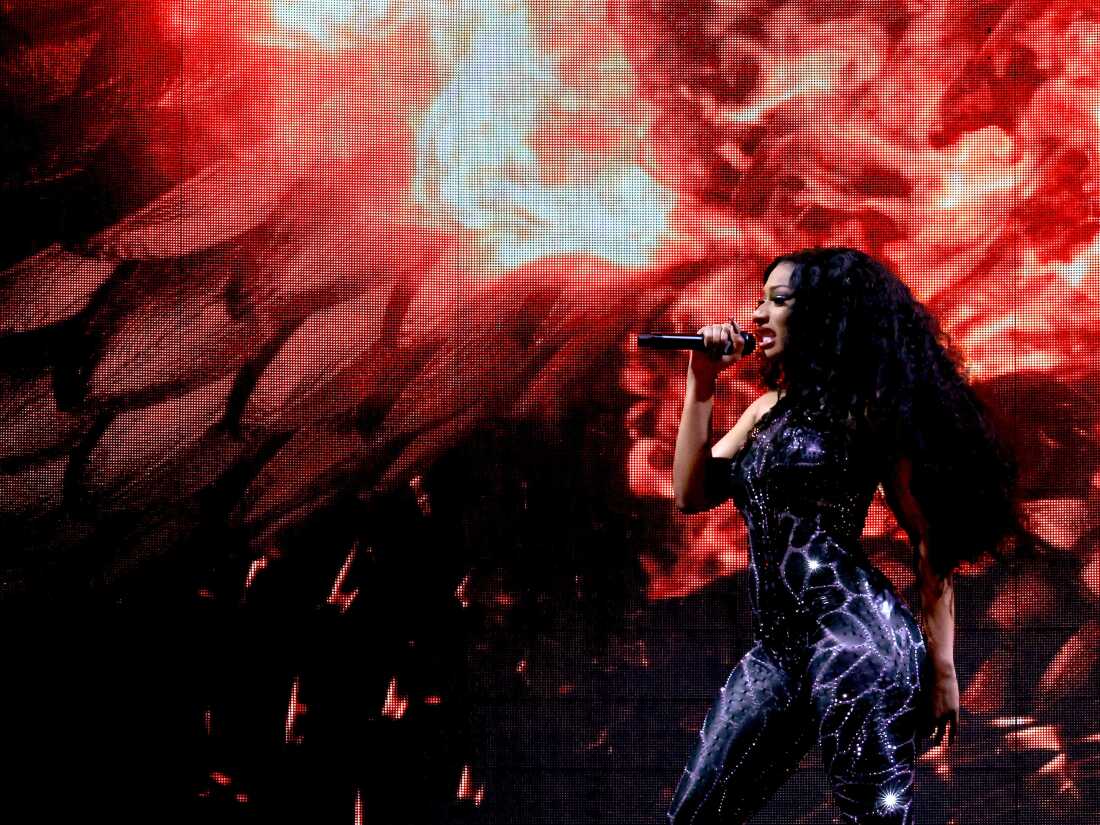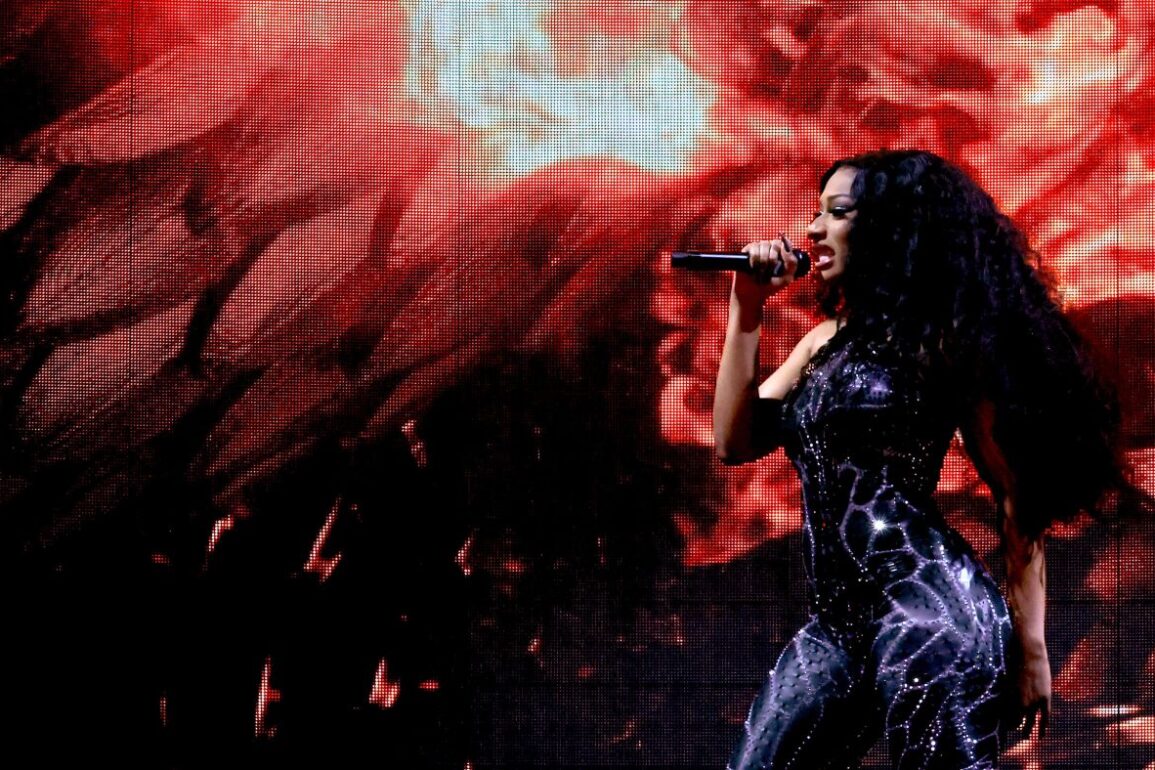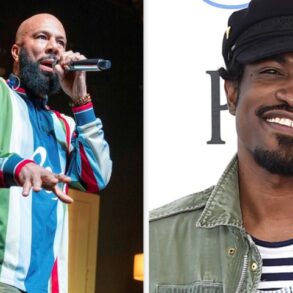
Megan Thee Stallion onstage in June at the Crypto.com Arena in Los Angeles, a stop on her Hot Girl Summer Tour.
Kevin Winter/Getty Images for Live Nation
Kevin Winter/Getty Images for Live Nation
These days, the music faucet never turns off: Pop into your listening app of choice on any given Friday, and the dozens of new albums pushed to you on the platform’s landing page will represent just a small portion of the deluge of music released that day. Overwhelm is a common dilemma across our current media environment, but its challenges are particularly fraught in rap, where life cycles have always been shortest. At times, it can feel as if prolificacy is required for artists to even make a dent, and even then, the greatest returns are often found in up-to-the-minute persona perpetuation. Just look at this year’s back-to-back Future & Metro Boomin albums, or the speed at which the Kendrick-Drake duel played out, or how Chief Keef followed a fascinating March collab with Mike WiLL by summer with a sequel to a different mixtape, or how Gunna keeps churning along despite the pending trial of his YSL label. The incessant push can be draining for all involved, but wade through the flotsam of the infinite stream at any point and you will discover that, in a climate that has encouraged sprawl, there are still plenty of artists choosing to either fight the current or weave around it, rather than surrender to the algorithm as the shaper of their vision.
Take, then, a packed release date from the midpoint of this year as an opportunity to witness this moment in cross-section. The spate of rap albums unveiled a few days ago, on June 28, illustrates vividly how much consequential new music is now put before fans in a single drop — but more than that, the experience of running through these diverse records seems to repel any and all generalizing statements about the “state of hip-hop.” The winds are blowing in too many different directions to speak definitively of where the culture is heading; the best we can do right now to survey this wide, unmappable landscape is to train our attention on the artists determined to plant a flag in it anyway.
Megan Thee Stallion, MEGAN
There are few more interesting case studies for artist engagement with the streaming apparatus than Megan Thee Stallion. A charismatic performer with elastic range and a piquant, slaphappy delivery, she has proven herself a dynamic exhibitionist, more song-focused than album-driven, concerned primarily with the snappiness and celerity of her sound. The climate into which she released her last album was nearly cheerless: She was in a legal dispute with her label, facing a polarized discourse amid the trial for singer and rapper Tory Lanez (who was later found guilty of shooting her), and still reeling from losing her mother and grandmother in 2019. The resulting work, 2022’s Traumazine, summoned a threaded precision of the level necessary to address all the things weighing on her. It also spiraled outward into feuds with Nicki Minaj and Drake, and given the ghastly atmosphere surrounding both Young Money alums of late, it has been even easier to root for the Texan, whose Hot 100-topping “Hiss” is among the best diss tracks in a year full of them. To see a Black woman who was subjected to violence and then unduly maligned for it get a win is a contagious want, especially considering the size of her talent.
Making the most of that goodwill, Megan emerges here for a self-titled third album that retains the charms her devotees are looking for, but also finds her caught between the yearning for another Hot Girl Summer and the need for greater narrative clarity to truly activate her potential. MEGAN sets the table with a snake theme it can’t always adhere to, its biting retorts at odds with the tongue-out sass and twerked agency of the fun-loving, mesmerizing cuts that helped make her both ambassador and target. If the album appears beset by the same haters and betrayers from Traumazine, Megan’s answer this time is to cover as much ground as possible, and the effects can induce whiplash — the distance between the cosplay of “Otaku Hot Girl” and the tongued-down erotica of “Down Stairs DJ” is vast. Neither routine is necessarily untrue to her many-faced persona; they are simply out of phase with one another. Still, even when Megan is being pulled in many directions, she never loses command of the seemingly endless flows that spill out of her, and her adaptability manifests in her sweeping knack for cooperation. Her partnerships with GloRilla (“Accent”), UGK (“Paper Together”) and Yuki Chiba, or KOHH (“Mamushi”), all come naturally, just as the qualities that seem to hinder her grand scheme nonetheless reaffirm her versatility.
Boldy James & Conductor Williams, Across the Tracks
Killer Mike may be grabbing the headlines for the awards procession afforded by his late-career breakthrough, Michael, but there is no late bloomer meeting his moment more exceptionally than Boldy James. The Detroit rapper didn’t come into his own until he was 30; now 41, he has his formula down to a science: methodically sequenced, single-producer projects that open gradually before you like a retractable hardtop. The second great album he’s released this year furthers an insular space that he has carefully molded for himself. If empathic coke rappers like Pusha T and Freddie Gibbs lavish in the outsized influence of their narcotic empires, James is possessed by details, enchanted more by the life itself than by the niceties and cred it supplies him.
With Kansas City beatmaker Conductor Williams by his side on Across the Tracks, James has rarely sounded smoother; he’s learned in recent years to use the rigidness of his voice to his advantage, his raps moving languidly along one frequency, suggesting not just ease but an icy demeanor. It’s there in the cobra-like way he describes himself on “All Madden”: “Real apex predator, real laid back.” There is a canniness to his performances, which often seem carefully mapped out even when he claims his style is imply a means to an end: “Only reason I trap because the only thing promised to me was the state bing / Hatin’ on me, you need to relax, only reason I rap ‘cause I can’t sing,” he raps on “The Ol Switcharoo.” The bars here are so deftly strung together as to make success feel inevitable, yet at all times, James cuts the figure of a withdrawn artisan, content to occupy his own little hole in the wall.
YN Jay, Flint 2 Detroit
About an hour from Boldy James’ stomping grounds, the goofball Flint rapper YN Jay has a different mandate. The self-proclaimed Coochie Man is similarly prolific, but his songs move with the slicked-back suaveness of a pimp. He makes the short drive over to the Motor City for his new project, which finds him parleying with the stars of the most vibrant scene of the 2020s — Payroll Giovanni, Sada Baby, Icewear Vezzo, Babyface Ray and Peezy, just to name a handful. (The only conspicuously absent name is Tee Grizzley.) He brings with him out of towners like BabyTron, Bfb da Packman and Rio Da Yung Og for cuts that move with the improvised swiftness of a secret handshake. Despite their eccentricities, all involved seem to speak the local language, communicated in part by the skipping, bass-boosted native sound. Throughout Flint 2 Detroit, it feels as if YN Jay is giving a guided tour, spotlighting a larger-than-life cast of characters that remain underappreciated by the wider rap public.
James Blake & Lil Yachty, Bad Cameo
The Atlanta-raised Lil Yachty, who once took on a similar Detroit-featuring gauntlet on 2021’s Michigan Boy Boat, has made many hairpin turns since (last year’s psychedelic odyssey Let’s Start Here the strangest among them), but his team-up with the electronic artist James Blake is the first to feel like more than the madcap chasing of creative impulses. Blake told Apple Music that most of these songs spawned from him simply playing beatless ambient music for Yachty, and the rapper conjuring a tune in about “20 seconds” — and yet the music produced in this way does not feel unconsidered. On the contrary, it feels as if Blake has pulled Yachty into the ghostly smear of his emotional realm, and Yachty, returning the gesture, has granted Blake access to his gift for uncanny melody. On songs like “In Grey” and “Twice,” you can hear them finding a middle ground, overlaying their respective robotic tendencies to generate a mumble-inflected form of chillout.
cupcakKe, Dauntless Manifesto
On the other end of the spectrum lies cupcakKe, who knows exactly what she wants her songs to do and has little use for the boundary-crossing moves of the genre-agnostic. She has two core modes, über-raunch and confrontational trash talk, unified by a foul-mouthed self-assurance. Her last album, Eden, was released in 2018, and after some personal turmoil that played out in public online, she went on an extended hiatus. As the title suggests, this is a confident reestablishment of the cupcakKe platform — body- and sex-positive raps that are as unrestrained as they are unfiltered. The beats are loud and outlandish. The raps are brash and bludgeoning. Few rappers have a more distinct sound and agenda, or are more assertive in presentation. And as a self-released project, Dauntless Manifesto moves with the swagger of freedom from oversight.
Lupe Fiasco, Samurai
I have always seen the craftsman ideal in Lupe Fiasco, whose pure love for words and the shape of rhymes betrays a poet’s heart. When Google wanted to test the viability of its Large Language Model as a tool for lyric generation, dubbed TextFX, the team called Lupe, a testament to both his uniquely analytical rap mind and also its occasionally machine-like output. An issue on many of his records is a tendency to get lost in the cypher, so caught up in rap schematics that he loses sense of its utility as music. Samurai is a reminder of just how captivating Lupe can be when he’s really on. “I’ve got these really neat, very beautifully alliterated battle raps for you,” he sings on the title track, and it really seems as if thinking of his slashing lyricism as kenjutsu frees him up to deploy his skills with purpose, as a showing of not just mastery but a sort of personal honor code. These songs have all of the sharpness of his greatest technical exploits, but they are staged with a flair for the dramatic. There is the obvious “No. 1 Headband,” which nods to the explosive anime Afro Samurai, but also the more subtle “Mumble Rap,” which plays with ideas of rap execution and the MC as a vessel for inspiration. In each case, he provides the most important demonstration of all: Even in intricacy, there can be play.
Previous Industries, Service Merchandise
If Lupe Fiasco has come to think of bars as the whetstone upon which a blade is sharpened for dueling, then the first album from Previous Industries — the group of Open Mike Eagle, Video Dave and Still Rift — adopts them as the invented language of a little fraternity, operating at smaller stakes but no less enamored with the whimsy of wordplay. On “Montgomery Ward,” Open Mike presents a hard truth of the trade: “Indie rappers deserve government subsidies / Or else we’ll make other discoveries / And have to publish findings reluctantly.” It’s a perfect encapsulation of the sidelining of a certain kind of humble alt-rap artist, as well as the central POV driving Service Merchandise. The raps aren’t actually angling for sponsorship; they are unassuming and self-effacing. There is an understanding that that subsidy isn’t coming, but that doing good work, even when marginal, can still be its own reward.
Open Mike isn’t just the best rapper here, he is one of the best anywhere, so the true feat of this record is how easily he settles into exchanges with his collaborators — matching their strides, never pulling too far ahead — for little rallies that can feel like playful banter among co-hosts. Collectively, they siphon their energy from nerdom, like Superman drawing power from Earth’s yellow sun. The references are plentiful, clever and familiar to a certain set: Tecmo Super Bowl, manga like Death Note and Fullmetal Alchemist, Bill & Ted, the Tekken games’ Heihachi Mishima, Tony Stark’s AI companion, Jarvis, and Star Wars’ Lando Calrissian. Still Rift name-drops Christopher Reeve and Christopher Lloyd in one closing frenzy. Whenever you drop the needle, it feels like stumbling in on reunited comrades brushing up on inside jokes from a shared past.
Headie One, The Last One
Finally, of the albums released in this batch, there is one that stands out as a microcosm of the contradictory landscape that surrounds it — an earnest attempt to play by the classicist traditions of the post-Illmatic statement album, while also fitting into the leave-nothing-unheard ethos of our current reality. Among the standouts in U.K. rap’s greatest generation, Headie One has made a career of post-prison tirades that utilize the crackle of local drill. The Last One is a pivot toward confessional, gut-spilling backstory, but it is also 20 songs crowded with guests, and there is a certain “let listeners sort it out” energy to its run, which comes in waves of trap, U.K. drill and Afrobeats that all work well as individual efforts, if less so as complementary ones. It feels a tad overstuffed, doing too much of everything, yet it’s hard to point to anywhere specific to cut. That’s because Headie really does seem to be drawing from many different parts of his history here — a Ghanaian lineage, a Tottenham upbringing, an adolescence spent navigating 11 London jails, an adjustment from homelessness to rap stardom. As an artist, he is very nearly the streaming ideal: international and genre-fluent, in touch with the streets but not limited to their corners, at once heady and personal and yet cosmopolitan and far-reaching.
In that way, The Last One seems to underscore the conundrum of modern music-making. Headie has never been more locked in, and yet the tug of the playlist economy is evident. How do you market individualized expression as a product when the infrastructure demands something more wide-reaching in scope? How do you cater to everyone without catering to no one? How do you put your all into crafting something meaningful when it may be swept away by the current in a few days? Apart from declining to play the game altogether, letting the art speak for itself no matter who is (or isn’t) listening, is there any resolving these questions? Perhaps not yet — but in a week like this, I’m encouraged by how many artists are still eagerly taking on the challenge.
This post was originally published on this site be sure to check out more of their content.







